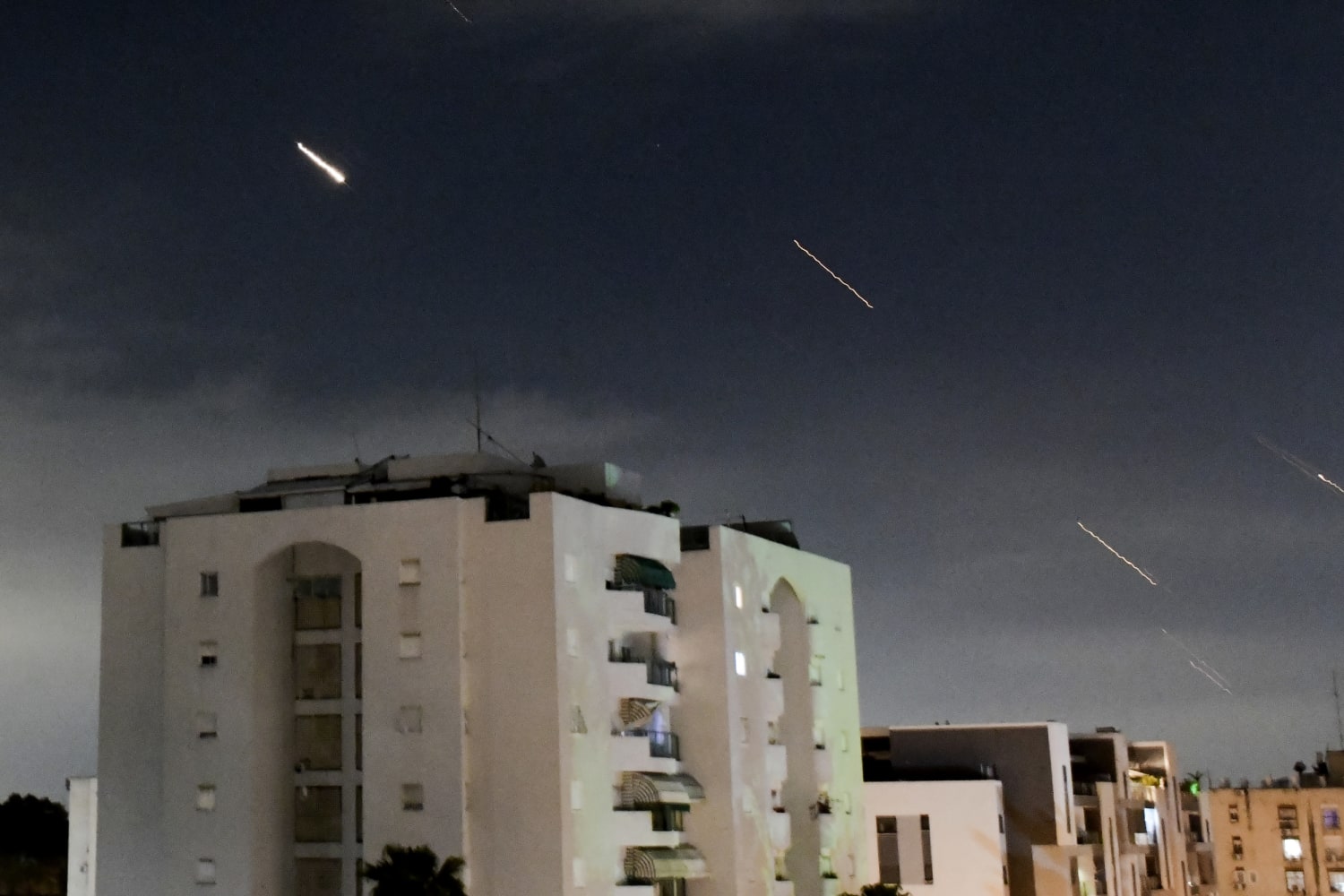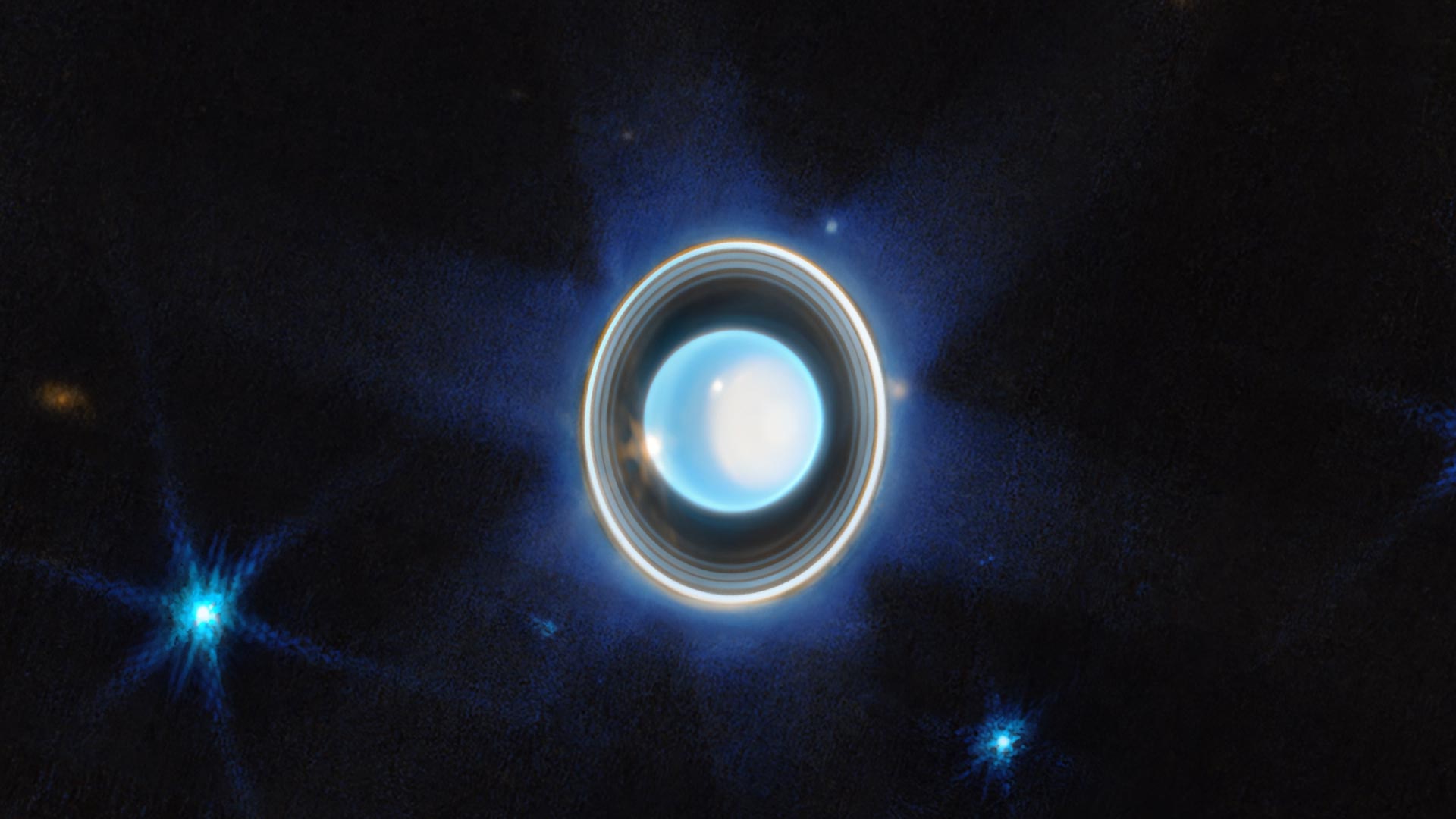Авторы и права: Наука: НАСА, ЕКА, CSA, STScI, обработка изображений: Джозеф ДиПаскуале (STScI)
Инфракрасное изображение Уэбба подчеркивает драматические кольца планеты и динамичную атмосферу.
Вселенная[{» attribute=»»>Uranus is an oddball in our solar system, tilted on its side as it orbits the sun, causing extreme seasons. While the planet’s atmosphere appeared nearly featureless when visited by the Voyager 2 spacecraft in 1986, subsequent observations from the ground and in space have shown turbulent storms.
NASA’s James Webb Space Telescope recently observed Uranus, and the resulting image highlights a complex system of rings as well as a bright polar cap and likely storm clouds.

This zoomed-in image of Uranus, captured by Webb’s Near-Infrared Camera (NIRCam) on February 6, 2023, reveals stunning views of the planet’s rings. The planet displays a blue hue in this representative-color image, made by combining data from two filters (F140M, F300M) at 1.4 and 3.0 microns, which are shown here as blue and orange, respectively. Credit: Science: NASA, ESA, CSA, STScI, Image Processing: Joseph DePasquale (STScI)
Webb Space Telescope Scores Another Ringed World with New Image of Uranus
Following in the footsteps of the Neptune image released in 2022, NASA’s James Webb Space Telescope has taken a stunning image of the solar system’s other ice giant, the planet Uranus. The new image features dramatic rings as well as bright features in the planet’s atmosphere. The Webb data demonstrates the observatory’s unprecedented sensitivity for the faintest dusty rings, which have only ever been imaged by two other facilities: the Voyager 2 spacecraft as it flew past the planet in 1986, and the Keck Observatory with advanced adaptive optics.
The seventh planet from the Sun, Uranus is unique: It rotates on its side, at roughly a 90-degree angle from the plane of its orbit. This causes extreme seasons since the planet’s poles experience many years of constant sunlight followed by an equal number of years of complete darkness. (Uranus takes 84 years to orbit the Sun.) Currently, it is late spring for the northern pole, which is visible here; Uranus’ northern summer will be in 2028. In contrast, when Voyager 2 visited Uranus it was summer at the south pole. The south pole is now on the ‘dark side’ of the planet, out of view and facing the darkness of space.

This zoomed-in image of Uranus, captured by Webb’s Near-Infrared Camera (NIRCam) on February 6, 2023, reveals stunning views of the planet’s rings. On the right side of the planet, there’s an area of brightening at the pole facing the Sun, known as a polar cap. This polar cap is unique to Uranus because it is the only planet in the solar system tilted on its side, which causes its extreme seasons. A new aspect of the polar cap revealed by Webb is a subtle brightening near the Uranian north pole. At the edge of the polar cap lies a bright cloud as well as a few fainter extended features just northward of the cap’s edge, and a second very bright cloud is seen at the planet’s left limb. Such clouds are typical for Uranus in infrared wavelengths, and likely are connected to storm activity. Credit: Science: NASA, ESA, CSA, STScI, Image Processing: Joseph DePasquale (STScI)
This infrared image from Webb’s Near-Infrared Camera (NIRCam) combines data from two filters at 1.4 and 3.0 microns, which are shown here in blue and orange, respectively. The planet displays a blue hue in the resulting representative-color image.
When Voyager 2 looked at Uranus, its camera showed an almost featureless blue-green ball in visible wavelengths. With the infrared wavelengths and extra sensitivity of Webb we see more detail, showing how dynamic the atmosphere of Uranus really is.

This wider view of the Uranian system with Webb’s NIRCam instrument features the planet Uranus as well as six of its 27 known moons (most of which are too small and faint to be seen in this short exposure). A handful of background objects, including many galaxies, are also seen. Credit: Science: NASA, ESA, CSA, STScI, Image Processing: Joseph DePasquale (STScI)
On the right side of the planet, there’s an area of brightening at the pole facing the Sun, known as a polar cap. This polar cap is unique to Uranus – it seems to appear when the pole enters direct sunlight in the summer and vanish in the fall; these Webb data will help scientists understand the currently mysterious mechanism. Webb revealed a surprising aspect of the polar cap: a subtle enhanced brightening at the center of the cap. The sensitivity and longer wavelengths of Webb’s NIRCam may be why we can see this enhanced Uranus polar feature when it has not been seen as clearly with other powerful telescopes like the Hubble Space Telescope and Keck Observatory.
At the edge of the polar cap lies a bright cloud as well as a few fainter extended features just beyond the cap’s edge, and a second very bright cloud is seen at the planet’s left limb. Such clouds are typical for Uranus in infrared wavelengths, and likely are connected to storm activity.
This planet is characterized as an ice giant due to the chemical make-up of its interior. Most of its mass is thought to be a hot, dense fluid of “icy” materials – water, methane, and ammonia – above a small rocky core.
Космический телескоп Джеймса Уэбба сделал потрясающее изображение другой ледяной планеты-гиганта Солнечной системы, Урана. На новом изображении видны захватывающие кольца, а также яркие элементы в атмосфере планеты. Новые данные Уэбба для Урана обеспечивают замечательную чувствительность, обнаруживая самое слабое из пылевых колец. Седьмая планета от Солнца, Уран, странная: она вращается на боку под углом около 90 градусов от плоскости своей орбиты. Это вызывает необычные времена года, поскольку полюса планеты испытывают 42 года непрерывного солнечного света и 42 года полной темноты (Урану требуется 84 года, чтобы совершить оборот вокруг Солнца). В настоящее время поздняя весна на Северном полюсе, который находится в правой части этого изображения; Северное лето будет на Уране в 2028 году.
У Урана известно 13 колец, и 11 из них видны на этом веб-изображении. Некоторые из этих колец настолько ярки у Уэбба, что, когда они расположены близко друг к другу, кажется, что они сливаются в одно большее кольцо. Девять классифицируются как главные кольца планеты, а два представляют собой слабые пылевые кольца (такие как диффузное кольцо Зеты, ближайшее к планете), которые не были обнаружены до пролета «Вояджера-2» в 1986 году. Ученые ожидают, что будущие изображения Урана, полученные Веббом, покажет два тусклых внешних кольца, которые были Узнайте с помощью Хаббла Во время кругового пересечения самолета в 2007 г.
Уэбб также запечатлел многие из 27 известных спутников Урана (большинство из них слишком маленькие и тусклые, чтобы их здесь можно было увидеть); На широкоэкранном изображении выделяются шесть самых ярких. Это было всего лишь короткое 12-минутное изображение Урана с двумя кандидатами. Это лишь верхушка айсберга того, что может сделать Уэбб, наблюдая за этой загадочной планетой. В настоящее время проводятся дополнительные исследования Урана, и в первый год научной деятельности Уэбба запланировано еще больше.
В 2022 году Национальные академии наук, инженерии и медицины определили науку об Уране в качестве приоритета в планетарных науках и астробиологии на 2023–2033 годы. Сканирование моего узла.
Космический телескоп Джеймса Уэбба — первая в мире обсерватория космических исследований. Он раскроет секреты нашей Солнечной системы, исследует далекие планеты вокруг других звезд, исследует загадочные структуры, происхождение Вселенной и наше место в ней. Программа является результатом сотрудничества между НАСА, Европейским космическим агентством (ЕКА) и Канадским космическим агентством и возглавляется НАСА.

«Наркоман поп-культуры. Поклонник телевидения. Ниндзя алкоголика. Абсолютный фанат пива. Профессиональный знаток твиттера».







More Stories
НАСА: необходим новый план по возвращению камней с Марса
Что делает этих маленьких «водяных медведей» такими выносливыми? Они быстро восстанавливают поврежденную ДНК.
Самый мощный космический взрыв в истории привел к удивительному развитию событий: ScienceAlert